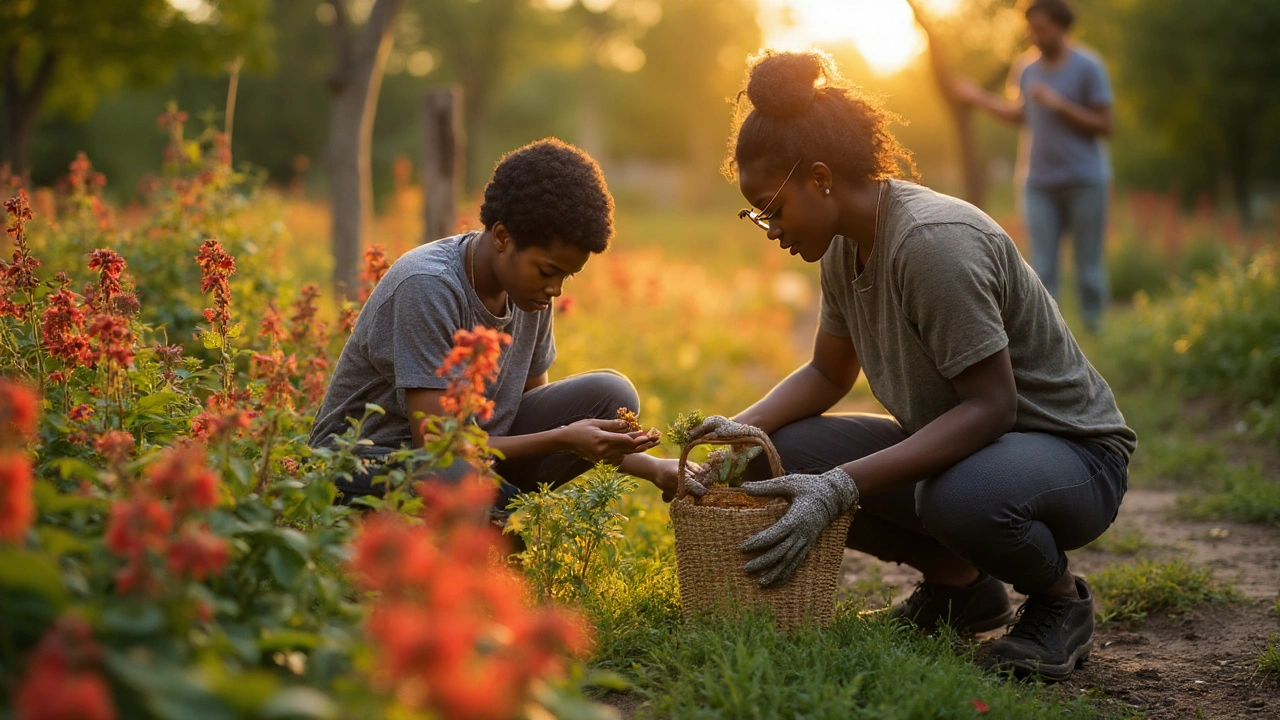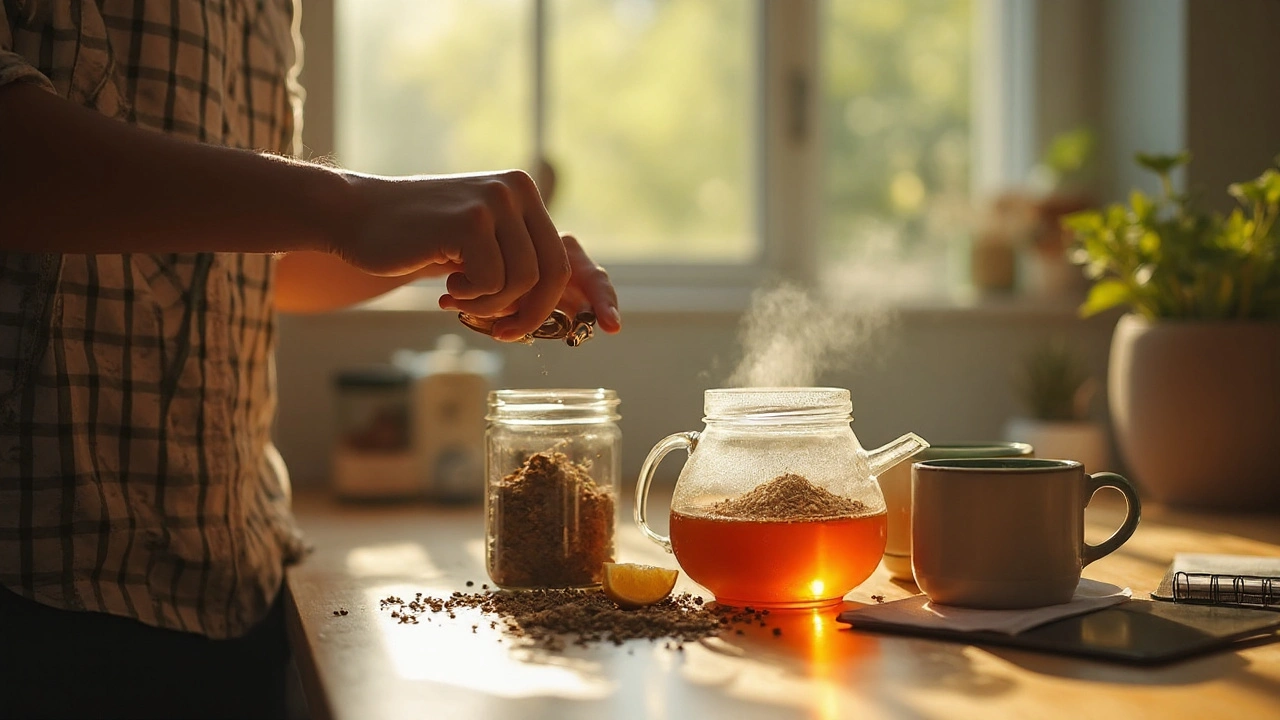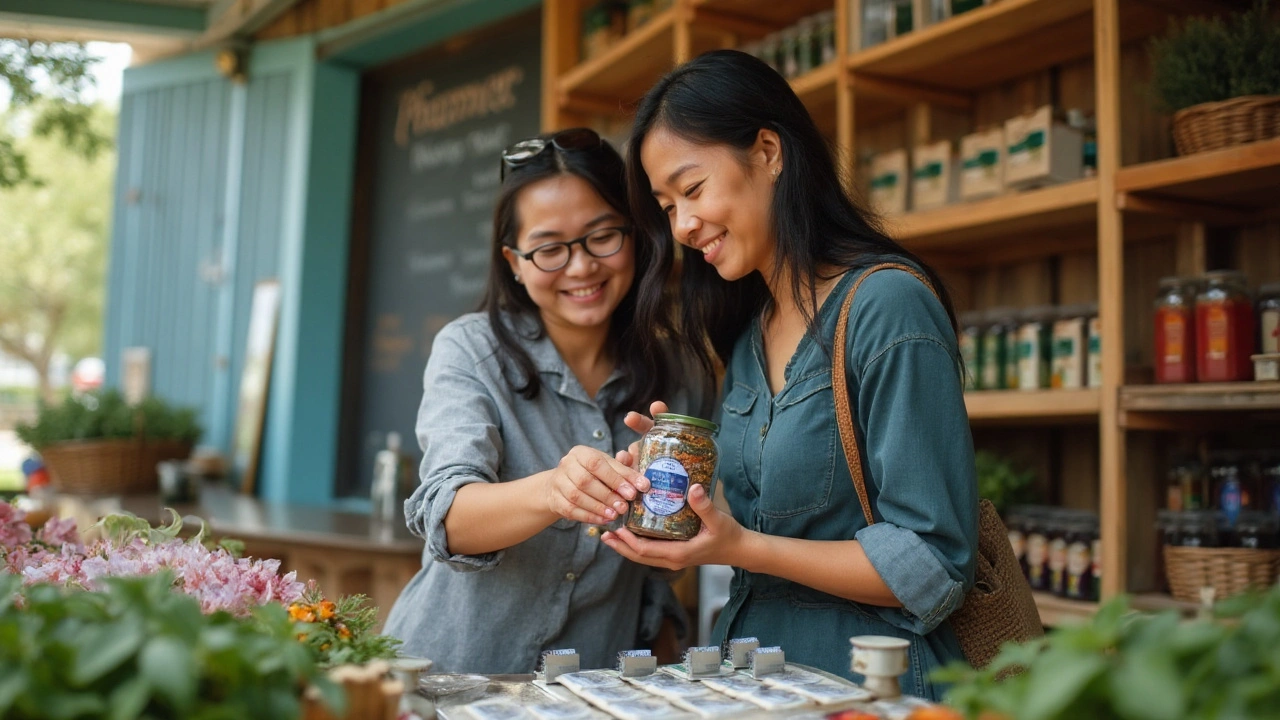
You want a daily herbal that actually earns a spot in your routine-something soothing for digestion, useful in cold season, and gentle enough to sip any day. Oswego tea (bee balm, Monarda didyma) checks those boxes with bright, minty-citrus flavor and a history that runs from Indigenous medicine to America’s “Liberty Tea.” Expect calm support, not miracles. It won’t replace your meds, but used right, it can make you feel better in small, steady ways. You’re here for Oswego tea benefits-and how to get them safely.
TL;DR
- What it can help: mild digestive discomfort, scratchy throats, stuffy noses, and everyday stress-backed by tradition and early lab data.
- How to use: 1-2 tsp dried leaf/flower per 8 oz water, steep 10-15 min, 1-3 cups/day. Tincture: 2-4 mL up to 3x/day.
- Safety: generally gentle; avoid if you’re allergic to mint family. If pregnant, nursing, or on meds (especially blood thinners), talk to your clinician first.
- Flavor tip: blend with lemon, honey, or ginger. Cold-brew for a softer, floral taste that’s less mint-forward.
- Buy right: look for “Monarda didyma” on the label, strong aroma, vibrant color, and recent harvest date.
What Is Oswego Tea? Benefits Backed by Tradition and Science
Oswego tea is the common name for the tea made from the leaves and flowers of Monarda didyma (bee balm), a North American mint-family plant. It’s aromatic, naturally caffeine-free, and tastes like mint with a twist of citrus and oregano. Indigenous communities used Monarda for stomach upsets and colds; later, colonists brewed it as “Liberty Tea” when they paused buying imported tea. That long use doesn’t prove everything, but it tells us the plant is workable in daily life.
Why it might help you comes down to its chemistry. Monarda species contain thymol and carvacrol (also found in thyme and oregano), plus rosmarinic acid and other polyphenols. These compounds show antimicrobial, antioxidant, and soothing properties in lab tests. Translation: they may gently support your throat, tummy, and sinuses when you’re feeling off. Direct human trials on Monarda are limited, so we connect the dots from related herbs and the plant’s constituents. Keep expectations realistic, and pay attention to how your own body responds.
Digestive comfort you can feel: many folks use bee balm like a “mint with backbone.” The aroma loosens that tight, post-meal bloat; warm tea eases queasiness and gas. Carminative herbs (the aromatic mint family) encourage the gut to relax. If spearmint or ginger agree with you, bee balm often does too. I reach for it after heavier dinners or when plane food leaves me unsettled.
Throat and upper-respiratory support: warm bee balm tea with honey hits a scratchy throat in two ways-heat and humidity soothe tissues, and those thyme-like aromatics can help you feel clearer. A simple steam is old-school and underrated. Pour just-boiled water over the herb, tent a towel, and breathe. Even five minutes can take the edge off a stuffy head.
Microbe-balancing edge: thymol and carvacrol are well-studied in food science for their antimicrobial effects against common bacteria and yeasts in vitro. That doesn’t mean bee balm tea works like an antibiotic, but it explains why a gargle can freshen breath and why the tea keeps well in the fridge. When your mouth feels “off,” a cooled gargle after brushing is a tidy routine.
Inflammation and antioxidant support: rosmarinic acid is a known antioxidant present in many mint-family plants (lemon balm, perilla, rosemary) and has been studied in humans for seasonal comfort. Monarda carries it too, likely at gentler levels. What you might notice in real life: less scratchiness in your throat and a subtle calming vibe after a cup. Again, subtle-not a knockout sedative.
Stress and mood: the ritual helps as much as the chemistry. The bright, herbaceous scent nudges your nervous system toward “rest-and-digest.” If you’re cutting afternoon caffeine, Monarda gives you that cuppa moment without the jitters and late-night payback.
What the experts say: for safety and identity, reference sources like the USDA PLANTS database (plant ID), the American Herbal Products Association’s Botanical Safety Handbook (general safety classes), and the NIH Office of Dietary Supplements (using botanicals alongside meds). The European Food Safety Authority has assessed thymol and carvacrol as flavorings, noting safety at typical dietary exposures. These don’t replace clinical trials on bee balm itself, but they help ground your decisions.
Bottom line on benefits: think “daily support herb,” not “cure.” If you want a calm stomach, a friend in cold season, and a soothing non-caffeinated ritual, Oswego tea earns its place.

How to Use Oswego Tea: Brewing, Dosage, and Practical Routines
Start simple and notice how your body responds over a week. Keep notes on taste, timing, and effects. Small tweaks-more herb, longer steep, different pairings-change the feel a lot.
Classic hot brew (my go-to):
- Measure 1-2 tsp dried Monarda didyma leaf/flower (or 1-2 Tbsp fresh) per 8 oz (240 mL) hot water.
- Water just off boil. Pour over herb in a covered mug or teapot.
- Steep 10-15 minutes. Longer gives a bigger, more thyme-like punch.
- Strain. Add lemon and a teaspoon of honey if your throat needs love.
- Drink 1-3 cups/day. After meals is a sweet spot for digestion.
Cold infusion (smoother, less minty):
- Use 2 tsp dried herb per 8 oz cold water in a jar.
- Refrigerate 6-10 hours, then strain. Keeps 48 hours in the fridge.
- Great as a mid-afternoon sipper when you’re dodging caffeine.
Steam inhalation (for stuffiness):
- Put 2 Tbsp dried bee balm in a bowl. Add 3 cups of boiling water.
- Tent with a towel and breathe through nose and mouth for 5-10 minutes.
- Keep eyes closed; it’s potent up close. Stop if it feels irritating.
Tincture and capsules: Tea is the easiest, but some people prefer drops or pills. Here’s a practical cheat-sheet:
| Form | Typical Dose | Best When | Onset | Notes |
|---|---|---|---|---|
| Hot Tea | 1-2 tsp dried/8 oz; 1-3 cups/day | After meals, throat support | 10-30 min | Hydration + aroma; adjust steep to taste |
| Cold Brew | 2 tsp dried/8 oz; sip over day | All-day hydration, gentle flavor | Steady | Lower bite; easy on sensitive stomachs |
| Tincture (1:5, 40% alc.) | 2-4 mL up to 3x/day | On the go, when tea isn’t handy | 15-45 min | Check alcohol-free glycerite if needed |
| Capsules | 300-500 mg dried herb, 1-3x/day | Travel, neutral taste | 30-60 min | Fewer aromatics vs. tea; read labels |
| Gargle | Strong tea, 30-60 sec, 1-2x/day | Breath freshness, throat tickle | Immediate | Spit after gargle if you don’t want to swallow |
Decision rules you can trust:
- If you want aroma-driven relief (throat, stress), pick tea or steam.
- If you can’t brew at work, use a tincture bottle and water chaser.
- If taste is a hard no, use capsules, but expect a subtler effect.
- If your stomach is sensitive, go cold-brew or shorter steeps.
Flavor boosters that do real work:
- Honey: coats the throat; also makes the bitter edge friendly.
- Lemon: brightens and adds vitamin C from the juice (not a megadose).
- Ginger: teams up on nausea and chills; 3-5 thin slices per mug.
- Thyme: doubles down on the herbal, thyme-like profile in cold season.
Two simple recipes:
- Liberty Blend: 1 tsp bee balm + 1 tsp lemon balm + 1 tsp black tea. Steep 5-7 minutes. Gives you a light caffeine lift with calm edges.
- Night Calm: 2 tsp bee balm + 1 tsp chamomile + lemon peel. Steep 10 minutes. No caffeine, soft citrus, bedtime-friendly.
When to drink: After meals for digestion, late afternoon instead of coffee, and evening for winding down. I avoid chugging right before bed to skip the 2 a.m. bathroom trip.
How much and for how long: Most people do fine at 1-3 cups/day. Try a 7-10 day “trial run” and check in with your notes. If you get what you want-keep it. If not, adjust steep time, add ginger or lemon, or switch to a tincture for two weeks.
Kids, pregnancy, and elders: Bee balm tea is generally gentle at culinary amounts. For kids, use half-strength tea and small servings (2-4 oz). During pregnancy or nursing, herbs deserve a quick chat with your clinician; stick to food-like, light use unless you get a thumbs-up. Elders often prefer cold-brew or shorter steeps to avoid intensity.

Safety, Quality, and Smart Buying (Plus FAQ and Next Steps)
Let’s keep this easy and safe. Bee balm is in the mint family (Lamiaceae). If you’ve had reactions to mint-family herbs (thyme, oregano, basil, rosemary), start with a tiny amount and watch for symptoms. Most people don’t have trouble, but we’re playing the long game here.
What to avoid:
- Essential oil internally: Monarda essential oil is concentrated. Do not ingest it without professional guidance. The tea, tincture, and capsules use the whole herb-very different.
- Overdoing it: Super-strong, quart-after-quart brews can irritate sensitive stomachs. If your gut pushes back, dilute or switch to cold-brew.
- Mixing with meds blindly: If you take blood thinners, antiplatelet meds, or have upcoming surgery, check with your clinician. Aromatic herbs can, in theory, nudge platelet behavior. If you take thyroid meds or have reflux, also check in-aromatics can be a little stimulating for some folks.
Good-to-know safety anchors: The AHPA Botanical Safety Handbook lists many mint-family herbs as safe at traditional doses. EFSA has safety opinions on thymol/carvacrol as flavorings at dietary levels. The NIH Office of Dietary Supplements offers guidance on integrating botanicals with care plans. Use those as guardrails, then personalize.
Buy the right stuff:
- Look for the Latin name: Monarda didyma (sometimes Monarda fistulosa is sold; it’s “wild bergamot,” similar but a bit different in flavor).
- Smell test: strong, bright, slightly citrus-thyme aroma. If it smells like hay or dust, it’s too old.
- Color: vibrant green leaves with ruby-pink to red flower bits. Brown = stale.
- Label basics: harvest or lot date, country of origin, and whether it’s organically grown or wildcrafted responsibly.
- Cut & sifted vs. tea bags: Cut leaf/flower usually tastes fresher and steeps better than powdery bags.
Storage checklist:
- Airtight jar, dark cupboard.
- Keep away from heat, light, and humidity.
- Best within 12 months; re-buy yearly for peak aroma.
Can you grow or forage it? If you garden, Monarda didyma is easy, gorgeous, and pollinator-friendly. Harvest just as flowers open for peak aromatics. Dry on screens in a single layer out of direct sun until crisp, then jar. Foraging is trickier-never harvest from sprayed areas, and be 100% sure of ID before you pick.
Mini-FAQ
- Will it help my cold? It won’t cure one, but hot tea, steam, and rest can make you feel better. Pair with hydration, sleep, and your clinician’s advice.
- Is it caffeine-free? Yes. Great swap for late-day coffee or black tea.
- Can I drink it daily? Yes, at culinary amounts. Many people use 1-2 cups most days.
- What does it taste like? Mint meets citrus and a whisper of oregano/thyme.
- Is Monarda fistulosa okay? Yes, flavor is more “wild” and less citrusy. Start with smaller amounts and adjust to taste.
Troubleshooting and next steps
- If you don’t feel anything: extend steep to 15 minutes, or switch to a tincture for two weeks. Also, try a cup after meals rather than on an empty stomach.
- If taste is too intense: shorten steep to 5-7 minutes, add lemon and honey, or go cold-brew-which is smoother.
- If your stomach feels warm or queasy: dilute, reduce dose, or pair with ginger. Back off if it persists.
- If you want a stronger “clear my head” effect: add 1/2 tsp culinary thyme or a slice of fresh ginger to the mug.
- If you need a travel plan: fill teabags with cut herb at home, or carry a small tincture bottle.
Who this helps most, in real life:
- Busy parents: a warm, caffeine-free cup after dinner to settle the stomach and mark the end of the day.
- Office folks ditching coffee: 2 p.m. Oswego tea instead of espresso to avoid the 9 p.m. stare-at-the-ceiling moment.
- Seasonal snifflers: a week-long routine-morning cup, evening steam, good sleep hygiene.
- Travelers: tincture drops before and after airplane meals to keep the gut on your side.
How to stack it with your routine:
- Morning: a light, 5-minute steep to wake your senses without caffeine.
- After lunch: 10-minute steep for post-meal calm.
- Evening: bee balm + chamomile + lemon peel, feet up, phone down.
Signals you picked a good product: you open the jar and the scent jumps out; first mug tastes bright and clean; you actually look forward to the second. If it doesn’t spark joy, try a different supplier-herbs vary a lot.
A quick word on expectations: botanicals work best as part of a pattern-sleep, hydration, movement, and smart meals. Oswego tea is a small lever. Pull it daily, and give it a couple of weeks to add up.
Credibility corner (so you know where this advice stands): Identification and botany are anchored by the USDA PLANTS database and common herbals. Safety framing comes from the American Herbal Products Association’s Botanical Safety Handbook and NIH’s Office of Dietary Supplements guidance on using botanicals with medications. Thymol/carvacrol dietary safety has been evaluated by the European Food Safety Authority as flavorings. Human trials specific to Monarda are limited; most efficacy signals come from tradition, lab work, and related mint-family research on rosmarinic acid-rich herbs. Keep your clinician in the loop, especially if you have conditions or take daily meds.
Wrap up your plan today: buy a fresh, aromatic batch labeled Monarda didyma, brew a test cup (10-minute steep), and journal how you feel for a week-digestion, throat, stress, and sleep. Adjust dose and timing, blend if needed, and keep only what clearly helps. Simple, steady, and kind to your system-that’s the Oswego way.




14 Comments
Just tried this after work tonight-steeped it with honey and lemon. My throat’s been scratchy all week, and this actually helped. Not magic, but it’s the kind of thing that makes you feel like you’re doing something gentle for yourself. Thanks for sharing.
Cold brew is life. I make a big jar every Sunday and sip it all week. No bitterness, just floral and calm. Perfect afternoon pick-me-up without the crash.
Thymol and carvacrol? You’re citing food-grade flavoring safety data as if it’s clinical evidence. This isn’t medicine. It’s aromatic water with a side of placebo effect. Don’t confuse tradition with pharmacology.
Monarda didyma’s rosmarinic acid content is approximately 0.8–1.2% dry weight, per USDA phytochemical database. Antioxidant capacity measured via DPPH assay shows IC50 ~45 µg/mL-significantly lower than green tea catechins. Context matters.
I grew this in my balcony garden last year. The bees went nuts. Made tea from the leaves and it smelled like my grandma’s kitchen in Kerala-herbal, sweet, weirdly familiar. I didn’t feel any ‘digestive magic’ but I loved the ritual. Sometimes that’s enough.
Liberty Tea? Really? Colonists brewed this because they were mad at the British… and now we’re calling it ‘wellness’? 😒
Meanwhile, actual herbalists in India have been using Ocimum sanctum for centuries to regulate stress and inflammation. But sure, let’s rebrand a native mint as ‘revolutionary’.
Appreciate the nuance here. Not every herb needs to be a miracle. I’ve been sipping this for six months now-mostly after meals. My bloating’s less intense, and I actually look forward to my tea time. It’s not about curing anything. It’s about being present with your body. That’s worth something.
So you’re telling me to drink tea because it’s ‘gentle’ and ‘subtle’?
Meanwhile my thyroid meds are on a warning label and you’re casually suggesting I ‘chat with my clinician’?
That’s not safety. That’s negligence wrapped in floral packaging.
People die from herb-drug interactions.
Stop romanticizing botanicals.
Just stop.
Try adding a pinch of turmeric to your hot brew. It plays nice with bee balm and adds anti-inflammatory backup. I’ve been doing this for cold season and honestly? Fewer sniffles.
Also-cold brew with mint? Game changer.
It’s nice that someone took the time to write this. But the entire piece reads like a marketing brochure disguised as a clinical guide. ‘Earns a spot in your routine’? ‘Subtle calming vibe’? This isn’t evidence-it’s poetry with footnotes. I’ll pass.
just made a batch with ginger and lemon and it smells like heaven 😭 i had a panic attack this morning and this tea made me feel like i could breathe again. thank you for writing this. i needed to read it.
Wait… you said ‘avoid if allergic to mint family’… but then you recommend thyme and oregano as blends? 😅
That’s like saying ‘don’t eat peanuts’ then adding peanut butter to your smoothie. 🤦♂️
Also-why no mention of Monarda fistulosa’s lower thymol content? You’re being inconsistent.
And why is the tincture dose so vague? ‘Up to 3x/day’? That’s not a dose-that’s a suggestion from a yoga retreat.
While the ethnobotanical lineage of Monarda didyma is well-documented among the Oswego Nation and later colonial populations, the pharmacological literature remains sparse in controlled human trials. One must distinguish between ancestral use and evidence-based efficacy. The presence of rosmarinic acid, while chemically plausible, does not constitute clinical validation. Further, the absence of standardized dosing protocols in commercial products introduces significant variability in bioavailability. One is advised to exercise caution and consult peer-reviewed phytotherapeutic compendia prior to routine utilization.
You call this a ‘guide’? You mention ‘lab data’ but cite zero studies. You reference EFSA and AHPA like they’re peer-reviewed journals. You didn’t even mention that Monarda didyma contains volatile oils that can interact with CYP3A4 substrates. If you’re going to write about herbal safety, at least be accurate. This is dangerously oversimplified.